Jupyter Snippet NP ch17-code-listing
Jupyter Snippet NP ch17-code-listing
Chapter 17: Signal processing
Robert Johansson
Source code listings for Numerical Python - Scientific Computing and Data Science Applications with Numpy, SciPy and Matplotlib (ISBN 978-1-484242-45-2).
import numpy as np
import pandas as pd
%matplotlib inline
import matplotlib.pyplot as plt
import matplotlib as mpl
from scipy import fftpack
# this also works:
# from numpy import fft as fftpack
from scipy import signal
import scipy.io.wavfile
from scipy import io
Spectral analysis of simulated signal
def signal_samples(t):
""" Simulated signal samples """
return (2 * np.sin(1 * 2 * np.pi * t) +
3 * np.sin(22 * 2 * np.pi * t) +
2 * np.random.randn(*np.shape(t)))
np.random.seed(0)
B = 30.0
f_s = 2 * B
f_s
60.0
delta_f = 0.01
N = int(f_s / delta_f)
N
6000
T = N / f_s
T
100.0
f_s / N
0.01
t = np.linspace(0, T, N)
f_t = signal_samples(t)
fig, axes = plt.subplots(1, 2, figsize=(8, 3), sharey=True)
axes[0].plot(t, f_t)
axes[0].set_xlabel("time (s)")
axes[0].set_ylabel("signal")
axes[1].plot(t, f_t)
axes[1].set_xlim(0, 5)
axes[1].set_xlabel("time (s)")
fig.tight_layout()
fig.savefig("ch17-simulated-signal.pdf")
fig.savefig("ch17-simulated-signal.png")
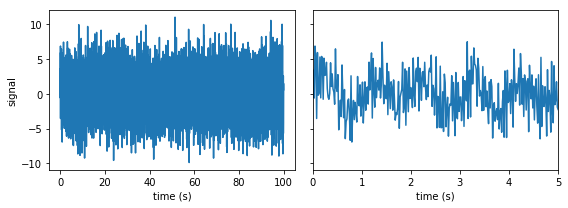
F = fftpack.fft(f_t)
f = fftpack.fftfreq(N, 1/f_s)
mask = np.where(f >= 0)
fig, axes = plt.subplots(3, 1, figsize=(8, 6))
axes[0].plot(f[mask], np.log(abs(F[mask])), label="real")
axes[0].plot(B, 0, 'r*', markersize=10)
axes[0].set_xlim(0, 30)
axes[0].set_ylabel("$\log(|F|)$", fontsize=14)
axes[1].plot(f[mask], abs(F[mask])/N, label="real")
axes[1].set_xlim(0, 2)
axes[1].set_ylabel("$|F|/N$", fontsize=14)
axes[2].plot(f[mask], abs(F[mask])/N, label="real")
axes[2].set_xlim(19, 23)
axes[2].set_xlabel("frequency (Hz)", fontsize=14)
axes[2].set_ylabel("$|F|/N$", fontsize=14)
fig.tight_layout()
fig.savefig("ch17-simulated-signal-spectrum.pdf")
fig.savefig("ch17-simulated-signal-spectrum.png")
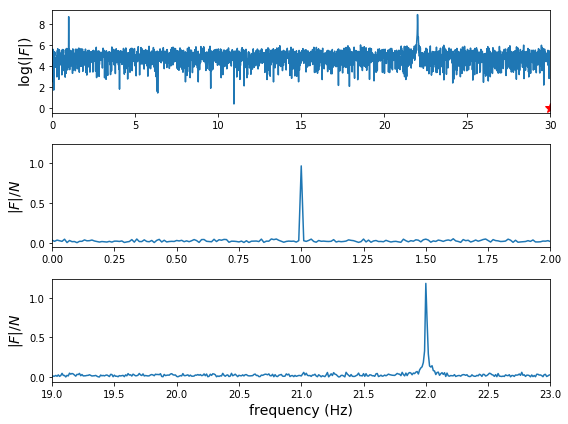
Simple example of filtering
F_filtered = F * (abs(f) < 2)
f_t_filtered = fftpack.ifft(F_filtered)
fig, ax = plt.subplots(figsize=(8, 3))
ax.plot(t, f_t, label='original', alpha=0.5)
ax.plot(t, f_t_filtered.real, color="red", lw=3, label='filtered')
ax.set_xlim(0, 10)
ax.set_xlabel("time (s)")
ax.set_ylabel("signal")
ax.legend()
fig.tight_layout()
fig.savefig("ch17-inverse-fft.pdf")
fig.savefig("ch17-inverse-fft.png")
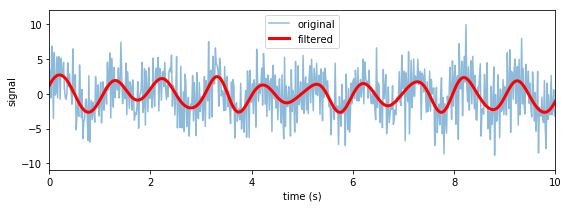
Windowing
fig, ax = plt.subplots(1, 1, figsize=(8, 3))
N = 100
ax.plot(signal.blackman(N), label="Blackman")
ax.plot(signal.hann(N), label="Hann")
ax.plot(signal.hamming(N), label="Hamming")
ax.plot(signal.gaussian(N, N/5), label="Gaussian (std=N/5)")
ax.plot(signal.kaiser(N, 7), label="Kaiser (beta=7)")
ax.set_xlabel("n")
ax.legend(loc=0)
fig.tight_layout()
fig.savefig("ch17-window-functions.pdf")
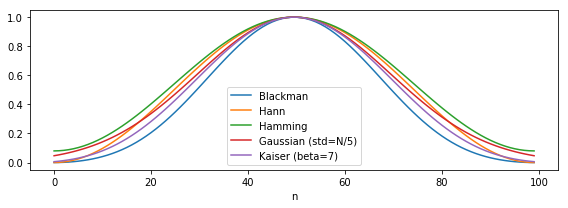
df = pd.read_csv('temperature_outdoor_2014.tsv', delimiter="\t", names=["time", "temperature"])
df.time = pd.to_datetime(df.time.values, unit="s").tz_localize('UTC').tz_convert('Europe/Stockholm')
df = df.set_index("time")
df = df.resample("1H").ffill()
df = df[(df.index >= "2014-04-01")*(df.index < "2014-06-01")].dropna()
time = df.index.astype('int')/1e9
temperature = df.temperature.values
temperature_detrended = signal.detrend(temperature)
window = signal.blackman(len(temperature_detrended))
temperature_windowed = temperature * window
data_fft = fftpack.fft(temperature)
data_fft_detrended = fftpack.fft(temperature_detrended)
data_fft_windowed = fftpack.fft(temperature_windowed)
fig, ax = plt.subplots(figsize=(12, 4))
ax.plot(df.index, temperature, label="original")
#ax.plot(df.index, temperature_detrended, label="detrended")
ax.plot(df.index, temperature_windowed, label="windowed")
ax.set_ylabel("temperature", fontsize=14)
ax.legend(loc=0)
fig.tight_layout()
fig.savefig("ch17-temperature-signal.pdf")
/Users/rob/miniconda3/envs/py3.6/lib/python3.6/site-packages/pandas/plotting/_converter.py:129: FutureWarning: Using an implicitly registered datetime converter for a matplotlib plotting method. The converter was registered by pandas on import. Future versions of pandas will require you to explicitly register matplotlib converters.
To register the converters:
>>> from pandas.plotting import register_matplotlib_converters
>>> register_matplotlib_converters()
warnings.warn(msg, FutureWarning)

fig, ax = plt.subplots(figsize=(12, 4))
ax.plot(df.index, temperature_windowed, label="original")
ax.plot(df.index, temperature_detrended * window, label="windowed")
ax.set_ylabel("detrended temperature", fontsize=14)
ax.legend(loc=0)
fig.tight_layout()
#fig.savefig("ch17-temperature-signal.pdf")

f = fftpack.fftfreq(len(temperature_windowed), time[1]-time[0])
mask = f > 0
fig, ax = plt.subplots(figsize=(12, 4))
ax.set_xlim(0.000001, 0.000025)
#ax.set_xlim(0.000005, 0.000018)
ax.set_xlim(0.000005, 0.00004)
ax.axvline(1./86400, color='r', lw=0.5)
ax.axvline(2./86400, color='r', lw=0.5)
ax.axvline(3./86400, color='r', lw=0.5)
ax.plot(f[mask], np.log(abs(data_fft[mask])**2), lw=2, label="original")
#ax.plot(f[mask], np.log(abs(data_fft_detrended[mask])**2), lw=2, label="detrended")
#ax.plot(f[mask], np.log(abs(data_fft_windowed[mask])**2), lw=2, label="windowed")
ax.set_ylabel("$\log|F|$", fontsize=14)
ax.set_xlabel("frequency (Hz)", fontsize=14)
ax.legend(loc=0)
fig.tight_layout()
fig.savefig("ch17-temperature-spectrum.pdf")

fig, ax = plt.subplots(figsize=(8, 3))
#ax.set_xlim(0.000001, 0.000025)
#ax.set_xlim(0.000005, 0.000018)
ax.set_xlim(0.000005, 0.00004)
ax.axvline(1./86400, color='r', lw=0.5)
ax.axvline(2./86400, color='r', lw=0.5)
ax.axvline(3./86400, color='r', lw=0.5)
y = np.log(abs(data_fft[mask])**2)
ax.plot(f[mask], y / y[10:].max(), lw=1, label="original")
y = np.log(abs(data_fft_detrended[mask])**2)
ax.plot(f[mask], y / y[10:].max(), lw=2, label="detrended")
y = np.log(abs(data_fft_windowed[mask])**2)
ax.plot(f[mask], y / y[10:].max(), lw=2, label="windowed")
ax.set_ylabel("$\log|F|$", fontsize=14)
ax.set_xlabel("frequency (Hz)", fontsize=14)
ax.legend(loc=0)
fig.tight_layout()
fig.savefig("ch17-temperature-spectrum.pdf")
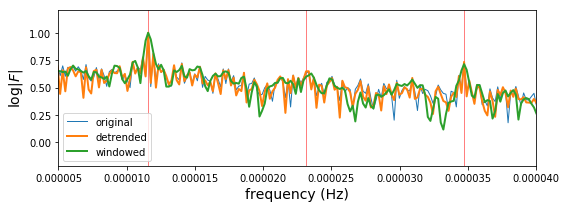
Spectrogram of Guitar sound
# https://www.freesound.org/people/guitarguy1985/sounds/52047/
sample_rate, data = io.wavfile.read("guitar.wav")
sample_rate
44100
data.shape
(1181625, 2)
data = data.mean(axis=1)
data.shape[0] / sample_rate
26.79421768707483
N = int(sample_rate/2.0); N # half a second
22050
f = fftpack.fftfreq(N, 1.0/sample_rate)
t = np.linspace(0, 0.5, N)
mask = (f > 0) * (f < 1000)
subdata = data[:N]
F = fftpack.fft(subdata)
fig, axes = plt.subplots(1, 2, figsize=(12, 3))
axes[0].plot(t, subdata)
axes[0].set_ylabel("signal", fontsize=14)
axes[0].set_xlabel("time (s)", fontsize=14)
axes[1].plot(f[mask], abs(F[mask]))
axes[1].set_xlim(0, 1000)
axes[1].set_ylabel("$|F|$", fontsize=14)
axes[1].set_xlabel("Frequency (Hz)", fontsize=14)
fig.tight_layout()
fig.savefig("ch17-guitar-spectrum.pdf")

N_max = int(data.shape[0] / N)
f_values = np.sum(1 * mask)
spect_data = np.zeros((N_max, f_values))
window = signal.blackman(len(subdata))
for n in range(0, N_max):
subdata = data[(N * n):(N * (n + 1))]
F = fftpack.fft(subdata * window)
spect_data[n, :] = np.log(abs(F[mask]))
fig, ax = plt.subplots(1, 1, figsize=(8, 6))
p = ax.imshow(spect_data, origin='lower',
extent=(0, 1000, 0, data.shape[0] / sample_rate),
aspect='auto',
cmap=mpl.cm.RdBu_r)
cb = fig.colorbar(p, ax=ax)
cb.set_label("$\log|F|$", fontsize=16)
ax.set_ylabel("time (s)", fontsize=14)
ax.set_xlabel("Frequency (Hz)", fontsize=14)
fig.tight_layout()
fig.savefig("ch17-spectrogram.pdf")
fig.savefig("ch17-spectrogram.png")
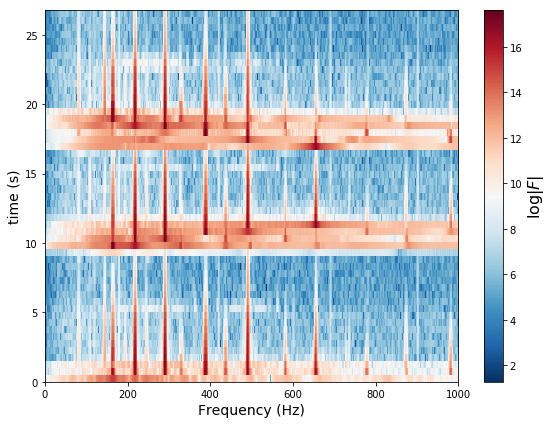
Signal filters
Convolution filters
# restore variables from the first example
np.random.seed(0)
B = 30.0
f_s = 2 * B
delta_f = 0.01
N = int(f_s / delta_f)
T = N / f_s
t = np.linspace(0, T, N)
f_t = signal_samples(t)
f = fftpack.fftfreq(N, 1/f_s)
H = (abs(f) < 2)
h = fftpack.fftshift(fftpack.ifft(H))
f_t_filtered_conv = signal.convolve(f_t, h, mode='same')
fig = plt.figure(figsize=(8, 6))
ax = plt.subplot2grid((2,2), (0,0))
ax.plot(f, H)
ax.set_xlabel("frequency (Hz)")
ax.set_ylabel("Frequency filter")
ax.set_ylim(0, 1.5)
ax = plt.subplot2grid((2,2), (0,1))
ax.plot(t - 50, h.real)
ax.set_xlabel("time (s)")
ax.set_ylabel("convolution kernel")
ax = plt.subplot2grid((2,2), (1,0), colspan=2)
ax.plot(t, f_t, label='original', alpha=0.25)
ax.plot(t, f_t_filtered.real, "r", lw=2, label='filtered in frequency domain')
ax.plot(t, f_t_filtered_conv.real, 'b--', lw=2, label='filtered with convolution')
ax.set_xlim(0, 10)
ax.set_xlabel("time (s)")
ax.set_ylabel("signal")
ax.legend(loc=2)
fig.tight_layout()
fig.savefig("ch17-convolution-filter.pdf")
fig.savefig("ch17-convolution-filter.png")
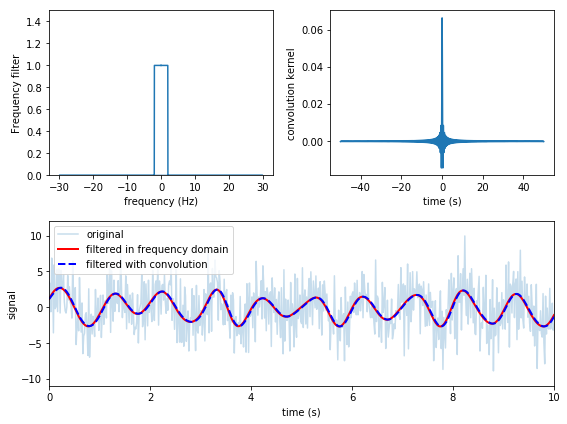
FIR filter
n = 101
f_s = 1.0 / 3600
nyq = f_s/2
b = signal.firwin(n, cutoff=nyq/12, nyq=nyq, window="hamming")
plt.plot(b);
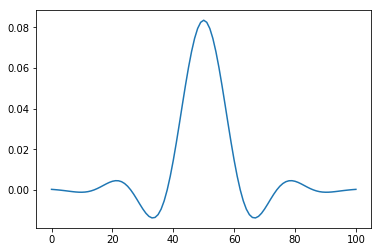
f, h = signal.freqz(b)
fig, ax = plt.subplots(1, 1, figsize=(8, 3))
h_ampl = 20 * np.log10(abs(h))
h_phase = np.unwrap(np.angle(h))
ax.plot(f/max(f), h_ampl, 'b')
ax.set_ylim(-150, 5)
ax.set_ylabel('frequency response (dB)', color="b")
ax.set_xlabel(r'normalized frequency')
ax = ax.twinx()
ax.plot(f/max(f), h_phase, 'r')
ax.set_ylabel('phase response', color="r")
ax.axvline(1.0/12, color="black")
fig.tight_layout()
fig.savefig("ch17-filter-frequency-response.pdf")
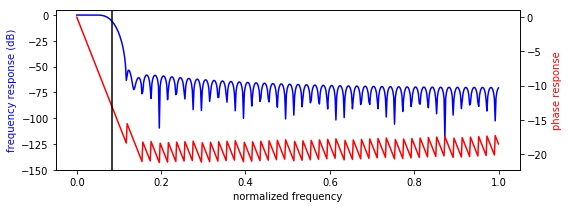
temperature_filtered = signal.lfilter(b, 1, temperature)
temperature_median_filtered = signal.medfilt(temperature, 25)
fig, ax = plt.subplots(figsize=(8, 3))
ax.plot(df.index, temperature, label="original", alpha=0.5)
ax.plot(df.index, temperature_filtered, color="green", lw=2, label="FIR")
ax.plot(df.index, temperature_median_filtered, color="red", lw=2, label="median filer")
ax.set_ylabel("temperature", fontsize=14)
ax.legend(loc=0)
fig.tight_layout()
fig.savefig("ch17-temperature-signal-fir.pdf")
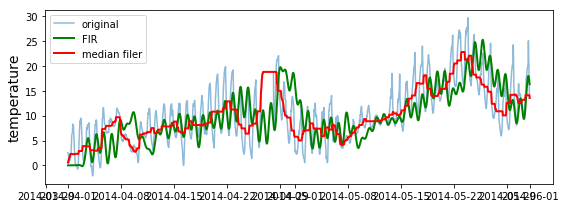
IIR filter
b, a = signal.butter(2, 14/365.0, btype='high')
b
array([ 0.91831745, -1.8366349 , 0.91831745])
a
array([ 1. , -1.82995169, 0.8433181 ])
temperature_filtered_iir = signal.lfilter(b, a, temperature)
temperature_filtered_filtfilt = signal.filtfilt(b, a, temperature)
fig, ax = plt.subplots(figsize=(8, 3))
ax.plot(df.index, temperature, label="original", alpha=0.5)
ax.plot(df.index, temperature_filtered_iir, color="red", label="IIR filter")
ax.plot(df.index, temperature_filtered_filtfilt, color="green", label="filtfilt filtered")
ax.set_ylabel("temperature", fontsize=14)
ax.legend(loc=0)
fig.tight_layout()
fig.savefig("ch17-temperature-signal-iir.pdf")
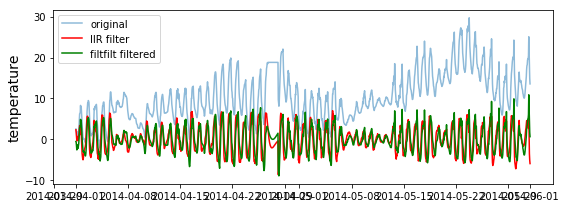
# f, h = signal.freqz(b, a)
fig, ax = plt.subplots(1, 1, figsize=(8, 3))
h_ampl = 20 * np.log10(abs(h))
h_phase = np.unwrap(np.angle(h))
ax.plot(f/max(f)/100, h_ampl, 'b')
ax.set_ylabel('frequency response (dB)', color="b")
ax.set_xlabel(r'normalized frequency')
ax = ax.twinx()
ax.plot(f/max(f)/100, h_phase, 'r')
ax.set_ylabel('phase response', color="r")
fig.tight_layout()
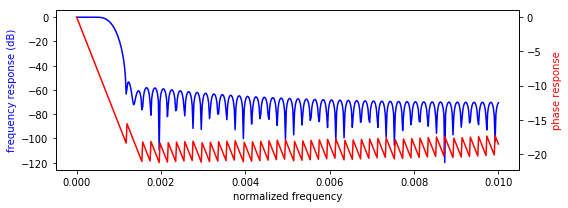
Filtering Audio
b = np.zeros(5000)
b[0] = b[-1] = 1
b /= b.sum()
data_filt = signal.lfilter(b, 1, data)
io.wavfile.write("guitar-echo.wav",
sample_rate,
np.vstack([data_filt, data_filt]).T.astype(np.int16))
# based on: http://nbviewer.ipython.org/gist/Carreau/5507501/the%20sound%20of%20hydrogen.ipynb
from IPython.core.display import display
from IPython.core.display import HTML
def wav_player(filepath):
src = """
<audio controls="controls" style="width:600px" >
<source src="files/%s" type="audio/wav" />
</audio>
"""%(filepath)
display(HTML(src))
wav_player("guitar.wav")
wav_player("guitar-echo.wav")
Versions
%reload_ext version_information
%version_information numpy, matplotlib, scipy